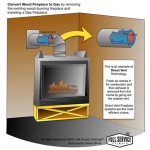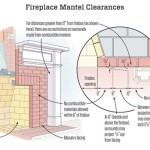Natural Gas Fireplace with Mantel: A Comprehensive Guide
A natural gas fireplace with a mantel is a popular choice for homeowners seeking the warmth and ambiance of a traditional fireplace without the complexities associated with wood-burning models. These fireplaces offer a convenient and efficient heating solution, combined with the aesthetic appeal of a decorative mantel. This article will delve into the various aspects of natural gas fireplaces with mantels, covering their benefits, types, installation considerations, maintenance requirements, and design options. Understanding these elements is crucial for making informed decisions when selecting and installing such a fireplace.
Natural gas fireplaces operate by burning natural gas, a readily available and relatively clean-burning fuel. The gas is supplied via a connection to a natural gas line, eliminating the need to store wood or other fuel sources. The flames produced are typically visible through a glass front, replicating the look of a traditional wood fire. A mantel, traditionally a shelf located above the fireplace opening, serves both a decorative and functional purpose. It provides a surface for displaying artwork, photographs, or other decorative items, and can also help to deflect heat away from the wall above the fireplace.
Benefits of a Natural Gas Fireplace with Mantel
Natural gas fireplaces with mantels offer several advantages over traditional wood-burning fireplaces and other heating methods. These benefits contribute to their increasing popularity among homeowners:
Convenience: Natural gas fireplaces are incredibly convenient to use. They can be ignited with the flip of a switch or the press of a button, often with remote control operation. This eliminates the need to gather, stack, and light wood, as well as the hassle of cleaning up ashes. The instant-on and instant-off functionality allows for quick and easy temperature control, making them ideal for supplemental heating.
Efficiency: Compared to wood-burning fireplaces, natural gas fireplaces are significantly more efficient. They convert a higher percentage of fuel into usable heat, reducing energy waste and lowering heating costs. Many models are equipped with features like thermostats and programmable timers, allowing for further optimization of energy consumption. The consistent heat output provides a reliable and predictable heating experience.
Cleanliness: Natural gas is a relatively clean-burning fuel, producing significantly fewer emissions than wood. This reduces air pollution and minimizes the impact on the environment. Furthermore, natural gas fireplaces do not produce the smoke, soot, and ash associated with wood-burning fireplaces, resulting in a cleaner indoor environment and less maintenance.
Safety: Modern natural gas fireplaces are designed with safety in mind. They typically feature sealed combustion chambers, which prevent dangerous gases from entering the home. Safety features such as oxygen depletion sensors (ODS) and automatic shut-off valves further enhance safety by detecting and mitigating potential hazards.
Aesthetics: A natural gas fireplace with a mantel can significantly enhance the aesthetic appeal of a room. The combination of the realistic flame display and the decorative mantel creates a warm and inviting atmosphere. A wide variety of mantel styles are available, allowing homeowners to choose a design that complements their existing décor and personal preferences.
Types of Natural Gas Fireplaces and Mantel Options
The market offers a diverse range of natural gas fireplaces and mantel options, catering to various aesthetic preferences and installation requirements:
Direct Vent Fireplaces: These fireplaces are considered the most efficient and safest option. They draw combustion air from outside the home and vent exhaust gases directly outdoors through a sealed vent system. This prevents indoor air from being used for combustion, improving indoor air quality and reducing the risk of carbon monoxide poisoning. Direct vent fireplaces offer installation flexibility, as they can be vented horizontally through a wall or vertically through the roof.
Vent-Free Fireplaces: Vent-free fireplaces, also known as ventless fireplaces, do not require a chimney or vent. They burn natural gas very cleanly, producing minimal emissions. However, they require proper ventilation to prevent the buildup of carbon monoxide. Vent-free fireplaces are often used as supplemental heating sources in rooms that are difficult to vent. Local building codes often regulate or restrict the use of vent-free fireplaces due to safety concerns.
B-Vent Fireplaces: B-Vent fireplaces utilize existing chimneys or vents to exhaust combustion gases. They are less efficient than direct vent fireplaces, as they draw combustion air from inside the home. B-Vent fireplaces require a functioning chimney or vent system that is properly sized and in good repair.
Electric Fireplaces (with Mantel): While not technically natural gas fireplaces, electric fireplaces with mantels offer a similar aesthetic appeal and are often considered as an alternative. They use electricity to simulate a flame and provide heat, offering easy installation and operation. While they lack the realism of a natural gas flame, they are a safe and convenient option for supplemental heating.
Mantel Materials and Styles: Mantels are available in a wide range of materials, including wood, stone, brick, and metal. Wood mantels are a classic choice, offering warmth and versatility. Stone mantels provide a more rustic and traditional look. Brick mantels can complement existing brickwork in the home. Metal mantels offer a modern and sleek aesthetic. Mantel styles range from traditional and ornate to contemporary and minimalist, allowing homeowners to find a design that suits their personal taste.
Mantel Shelves: Many homeowners opt for a simple mantel shelf instead of a full mantel surround. Mantel shelves are a minimalist option that provides a surface for display without overwhelming the fireplace. They are available in various materials and styles to match the fireplace design.
Installation and Maintenance Considerations
Proper installation and regular maintenance are crucial for ensuring the safe and efficient operation of a natural gas fireplace with a mantel. These considerations should be carefully addressed:
Professional Installation: It is strongly recommended that a qualified and licensed professional install a natural gas fireplace. A professional installer will ensure that the fireplace is properly connected to the gas line, vented correctly, and meets all applicable building codes. Improper installation can lead to gas leaks, carbon monoxide poisoning, and other safety hazards. The installation typically involves running a gas line, connecting the venting system, and securing the fireplace unit.
Gas Line Connection: The natural gas line must be properly sized and installed to provide adequate gas pressure to the fireplace. A qualified plumber or gas fitter should handle this aspect of the installation. They will ensure that the gas line is leak-tested and meets all safety requirements.
Venting Requirements: The venting system must be properly installed and sized to ensure adequate exhaust of combustion gases. Direct vent fireplaces require a specific type of venting system that is designed for sealed combustion. B-Vent fireplaces require a functioning chimney or vent that is properly sized and in good repair. Vent-free fireplaces require adequate ventilation in the room to prevent the buildup of carbon monoxide.
Building Codes and Permits: Before installing a natural gas fireplace, it is essential to check local building codes and obtain any necessary permits. Building codes typically regulate the installation of gas appliances, including venting requirements, clearances to combustible materials, and safety features. Obtaining the necessary permits ensures that the installation meets all applicable safety standards.
Regular Maintenance: Regular maintenance is essential for ensuring the safe and efficient operation of a natural gas fireplace. This includes cleaning the glass front, inspecting the burner, and checking the venting system. The glass front should be cleaned regularly to remove soot and debris, which can obstruct the view of the flames. The burner should be inspected for clogs or damage, and cleaned as necessary. The venting system should be inspected for obstructions and leaks.
Annual Inspection: It is recommended to have a qualified technician inspect the fireplace annually. A professional inspection can identify potential problems before they become serious, ensuring the safe and reliable operation of the fireplace. The technician will typically inspect the gas line, burner, venting system, and safety features.
Carbon Monoxide Detectors: Carbon monoxide detectors should be installed in the home, especially near bedrooms and living areas. Carbon monoxide is a colorless and odorless gas that can be produced by malfunctioning gas appliances. Carbon monoxide detectors provide an early warning of dangerous levels of carbon monoxide, allowing occupants to evacuate the home and prevent poisoning.
By carefully considering these installation and maintenance considerations, homeowners can ensure the safe and efficient operation of their natural gas fireplace with a mantel, enjoying the warmth and ambiance it provides for years to come.

Marquess Keenan Mantels Mm Gas Fireplace Mantel Toronto Best

Duluth Forge 41 75 In Dual Fuel Ventless Gas Fireplace With Mantel 26 000 Btu T Stat Control Apple Spice At Tractor Supply Co

Empire Vail 24 Series Gas Fireplace Fine S

Empire Cabinet Mantel For 36 Fireplaces

Duluth Forge 45 In Dual Fuel Ventless Gas Fireplace With Mantel 32 000 Btu Remote Control Antique White At Tractor Supply Co

Empire 24 Inch Vail Vent Free Natural Gas Fireplace
:max_bytes(150000):strip_icc()/ventless-gas-fireplaces-4160746-hero-f9d4bdcd9bd446eb84406de306f790ba.jpg?strip=all)
How To Pick Out A Ventless Gas Fireplace

Duluth Forge Dual Fuel Ventless Gas Fireplace 32 000 Btu T Stat Control Antique White Finish Com

Types Of Fireplaces And Mantels The Home Depot

How To Modernize And Update A Gas Fireplace We Love Fire
Related Posts








